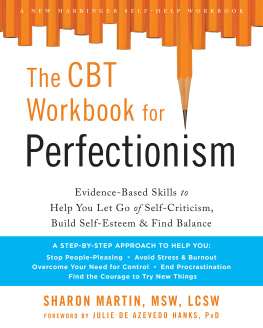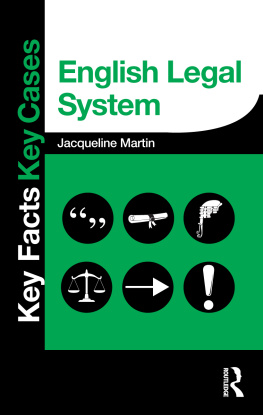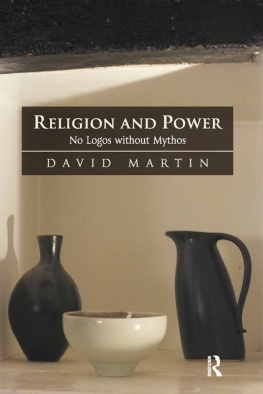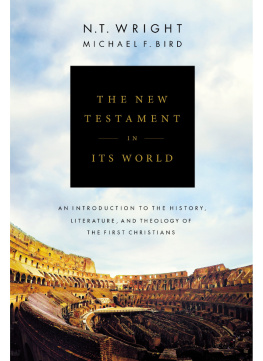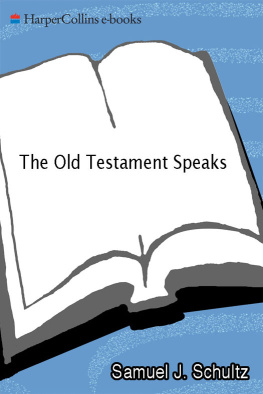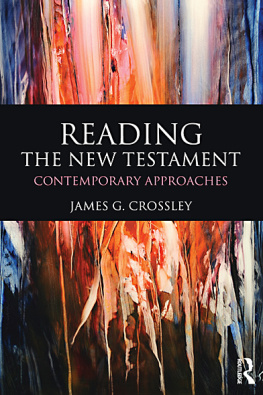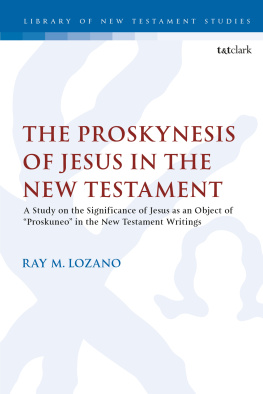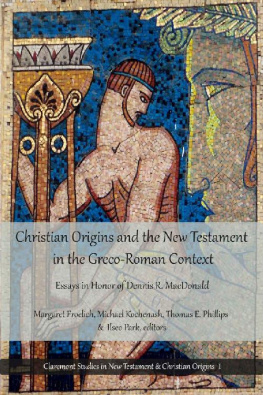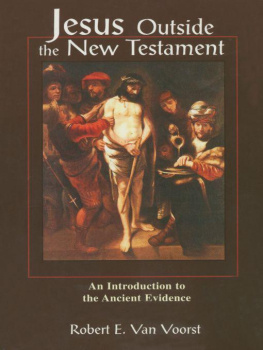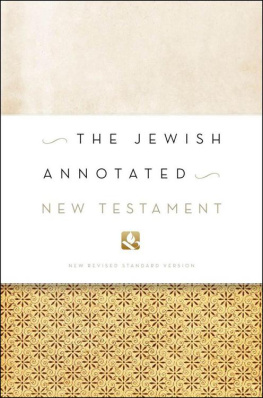New Testament History and Literature
THE OPEN YALE COURSES SERIES is designed to bring the depth and breadth of a Yale education to a wide variety of readers. Based on Yales Open Yale Courses program (http://oyc.yale.edu), these books bring outstanding lectures by Yale faculty to the curious reader, whether student or adult. Covering a wide variety of topics across disciplines in the social sciences, physical sciences, and humanities, Open Yale Courses books offer accessible introductions at affordable prices.
The production of Open Yale Courses for the Internet was made possible by a grant from the William and Flora Hewlett Foundation.
RECENT TITLES
Paul H. Fry, Theory of Literature
Shelly Kagan, Death
Dale B. Martin, New Testament History and Literature
FORTHCOMING TITLES
Christine Hayes, Introduction to the Old Testament
Ian Shapiro, The Moral Foundations of Politics
Steven B. Smith, Introduction to Political Philosophy
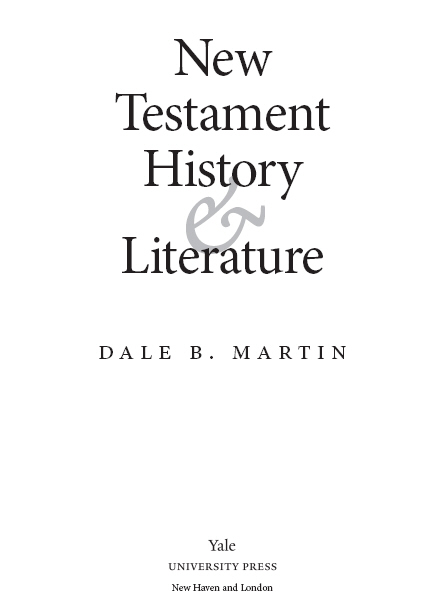
Copyright 2012 by Yale University.
All rights reserved.
This book may not be reproduced, in whole or in part, including illustrations, in any form (beyond that copying permitted by Sections 107 and 108 of the U.S. Copyright Law and except by reviewers for the public press), without written permission from the publishers.
Yale University Press books may be purchased in quantity for educational, business, or promotional use. For information, please e-mail sales.press@yale.edu (U.S. office) or sales@yaleup.co.uk (U.K. office).
Unless otherwise noted, the scripture quotations contained herein are from the New Revised Standard Version (NRSV) Bible, copyright 1989 by the Division of Christian Education of the National Council of the Churches of Christ in the USA, and are used by permission. All rights reserved.
Set in Minion type by Westchester Book Group
Printed in the United States of America
Library of Congress Cataloging-in-Publication Data
Martin, Dale B., 1954
New Testament history and literature / Dale B. Martin.
p. cm. (The open Yale courses series)
Includes bibliographical references and indexes.
ISBN 978-0-300-18085-5 (pbk. : alk. paper) 1. Bible. N.T.Criticism, interpretation, etc. 2. Christian literature, EarlyHistory and criticism. I. Title.
BS2361.3.M37 2012
225.6'1dc23
2011045262
A catalogue record for this book is available from the British Library.
This paper meets the requirements of ANSI/NISO Z39.48-1992 (Permanence of Paper).
10 9 8 7 6 5 4 3 2 1
To all the students Ive been privileged to teach over the past twenty-five years at Rhodes College, Duke University, and Yale University
Contents
When editors at Yale University Press invited me to turn the lectures of my course Introduction to the New Testament into a book, I think they must have assumed, as I know I did, that doing so would be a matter of editing the existing transcripts. Once I began the task, however, I quickly discovered that the lectures as I gave them needed much more than mere editing. Perhaps some instructors lecture in printable prose, but I do not. When I lecture, which I do from notes and outlines, not from fully written texts, I digress a lot, fail to finish sentences, start on one point only to discover that I must return to another, and so forth. Ive found that I chatter a lot when I lecture. The way I speak resists proper prose style. I therefore used the spoken lectures as guides, but ended up having to write these chapters as if from the bottom up. The chapters follow the basic content of the lectures, but not the actual language. That writing process has allowed me sufficient freedom to bring the lectures up-to-date (they were recorded in 2009), to correct mistakes, and to fill in material sometimes unfortunately left out in the original presentation.
I owe many people thankspeople who have over the years offered comments and suggestions and who will have to remain nameless simply because there are too many of them. The person who deserves the most thanks is Sonja Anderson, a Yale doctoral student in New Testament studies. Sonja read every word and offered countless suggestions. She corrected mistakes, proposed alternative wording, and brought up needed additions. Her superb editing rid the manuscript of many infelicities. And she provided most of the references and notes. She did this, moreover, in a feverish pace over one quick summer. This is one case where the phrase I couldnt have done this without her is perfectly accurate and more than merited.
Matthew Croasmun, another doctoral student in the same program, did an excellent job producing all the illustrations, with the exception of the map, which was drawn by Bill Nelson, whom I also thank. I thank Matt, moreover, for his reading of the manuscript and suggestions for improvements. Others who read the manuscript and came back to me with suggestions are Chungsen Cheng and my sister, Ferryn Martin. They deserve hearty and explicit thanks.
I have been teaching college students some kind of Introduction to the New Testament for my entire career. The precise content of the course has naturally changed many times, and Im still altering and trying to improve it every time I teach it. It is a nice coincidence that this book is coming out twenty-five years after I first began teaching full-time, in 1987 at Rhodes College. I deeply appreciate all the bright and eager students I have had the privilege to teach, first there, then at Duke University, and now at Yale. I dedicate this book to all those students with gratitude and fond memories.

Fig. 1 The Ancient Mediterranean World in the East. Map by Bill Nelson.

CHAPTER 1
Overview: This book approaches the New Testament not as scripture, or a piece of authoritative holy writing, but as a collection of historical documents. Therefore, readers are urged to leave behind their preconceived notions of the New Testament and read it as if they had never heard of it before. This involves understanding the historical context of the New Testament and imagining how it might appear to an ancient person.
Why Study the New Testament?
The first question people should ask themselves when they are taking up the study of the New Testament is why they want to study it. What is the New Testament, and why should one study it? The first answer many people giveand for many, the most obviousis, Because Im a Christian. Or perhaps, I believe the New Testament is scripture.
The problem with that answer, at least as it relates to this book on the New Testament, is that the New Testament isnt scripture for everyone. When we say that the New Testament is scripture, we have to identify for whom it is scripture. What does it mean to call a document scripture? In Christianity, when people call the Bible scripture, that often means they intend to listen to the text for the Word of God, whether read in church or alone at home. Christians often expect the Holy Spirit or God to communicate to them and to their church, or to some broader community, through this document.
But the text of the Bible is not scripture in itself. It is scripture only to a community of people who take it as scripture. The text itself, any text, is not holy writing. Originally, the word in Latin ( scriptura ) meant simply something written, but we now take the word to mean holy writing, sacred writing. The writing, however, is not holy in itself. It is holy only to people who take it as holy.
Next page

